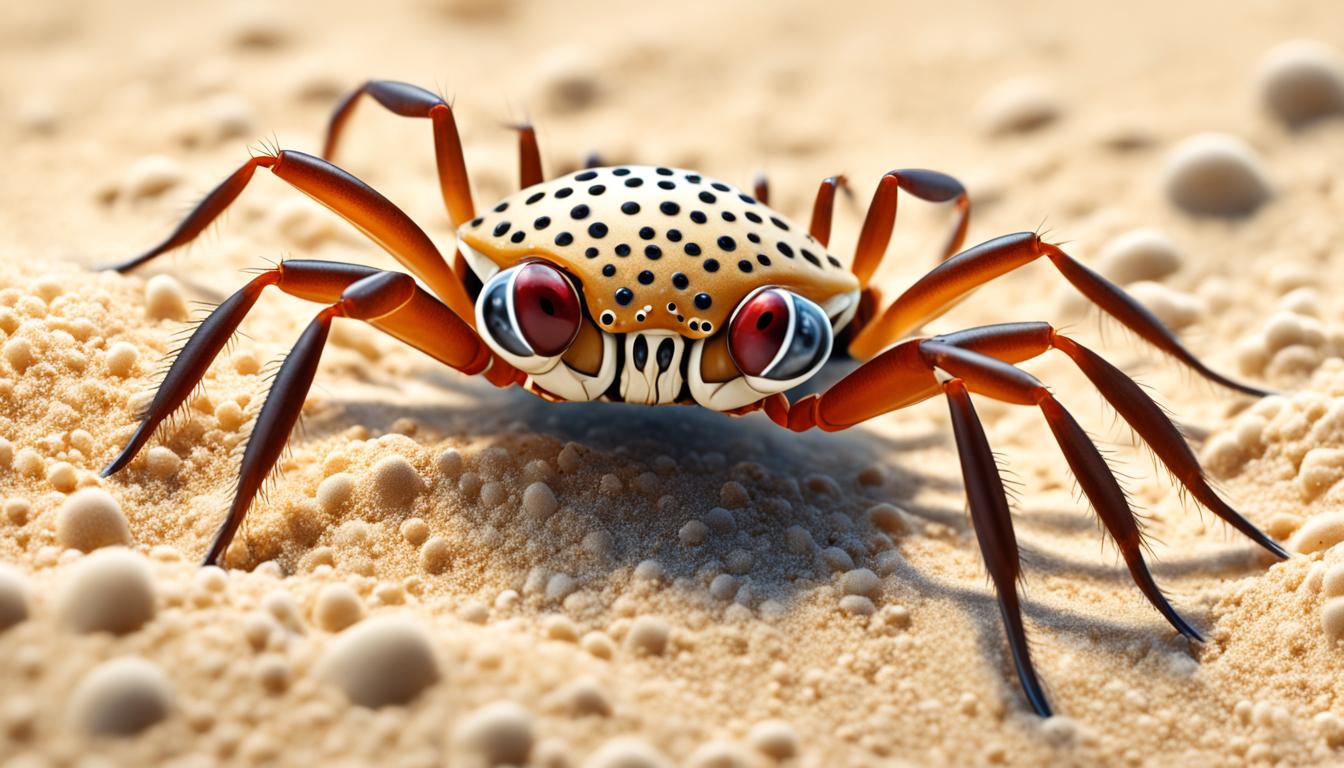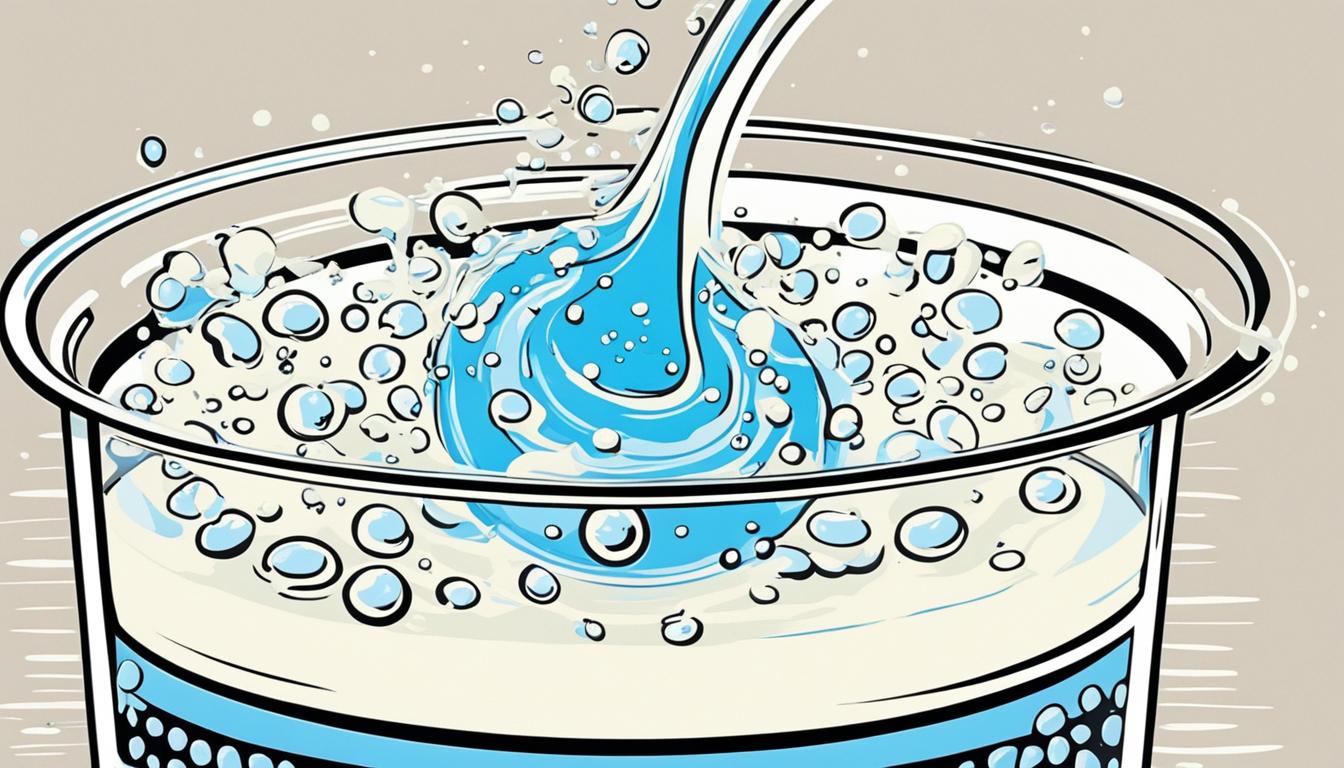Sand fleas, also called beach fleas or sand hoppers, live in sandy spots under rocks and plants. They are small crustaceans, not harmful to humans or pets. These creatures love the night for finding food and sticking to the beach.
Many people confuse them with biting bugs like gnats or midges by the coast. It’s key to know the difference. This knowledge helps in knowing the risks and how to prevent issues.
Key Takeaways:
- Sand fleas, also known as beach fleas or sand hoppers, are small crustaceans that live in sandy areas.
- They do not bite humans or pets and are not harmful.
- They are most active at night and forage for food in their beach environment.
- It is important to differentiate between sand fleas and other coastal insects.
- Understanding the risks and prevention methods can help avoid confusion and unnecessary concern.
What are Sand Fleas?
Sand fleas, also known as beach fleas, live in sandy places like beaches. They come in colors like gray, brown, or tan. This helps them hide in the sand.
These creatures have a lot of legs, long antennae, and two forked parts at their back. This helps them move in the sand and find their way around.
Even though they’re called fleas, sand fleas aren’t related to real fleas. They don’t bite humans or animals. Instead, they eat things like dead seaweed and debris on the beach.
Despite looking similar and jumping like real fleas, sand fleas don’t suck blood. They’re important because they help break down dead stuff and recycle nutrients in their home.
Sand fleas come out at night from under the sand. This is when they look for food and do their typical activities. Because they’re active at night, some people mix them up with biting bugs like gnats.
It’s key to remember sand fleas can’t bite because their mouths aren’t made for that. So, they’re safe to be around when you’re enjoying the beach or outdoor activities.
Characteristics of Sand Fleas:
- Small crustaceans that live in sandy places
- Colors that help them blend in with the sand
- Lots of legs, long antennae, and two forked parts at the back
- Active at night
- They eat dead things, not blood
- They don’t bite humans or animals
Knowing about sand fleas can help people at the beach tell them apart from bugs that bite. This way, everyone can have fun without worrying.
| Sand Fleas | Other Insects |
|---|---|
| Small crustaceans | Various insect species |
| Nocturnal and most active at night | Active during the day |
| Feed on rotting organic matter | Feed on blood or plant nectar |
| Gray, brown, or tan color blending with the sand | Varied colors depending on species |
| Do not bite humans or pets | May bite humans or pets |
Sand Fleas and Humans
Many people think sand fleas cause the bites and welts at beaches. But, sand fleas are harmless to humans. They don’t bite or make you itch.
The real troublemakers are sandflies, which do bite. Unlike sand fleas, sandflies feed on blood. This is why we get itchy bites.
It’s crucial to know the difference between sand fleas and other insects. This stops panic and confusion. Knowing this helps us take the right steps to prevent bites.
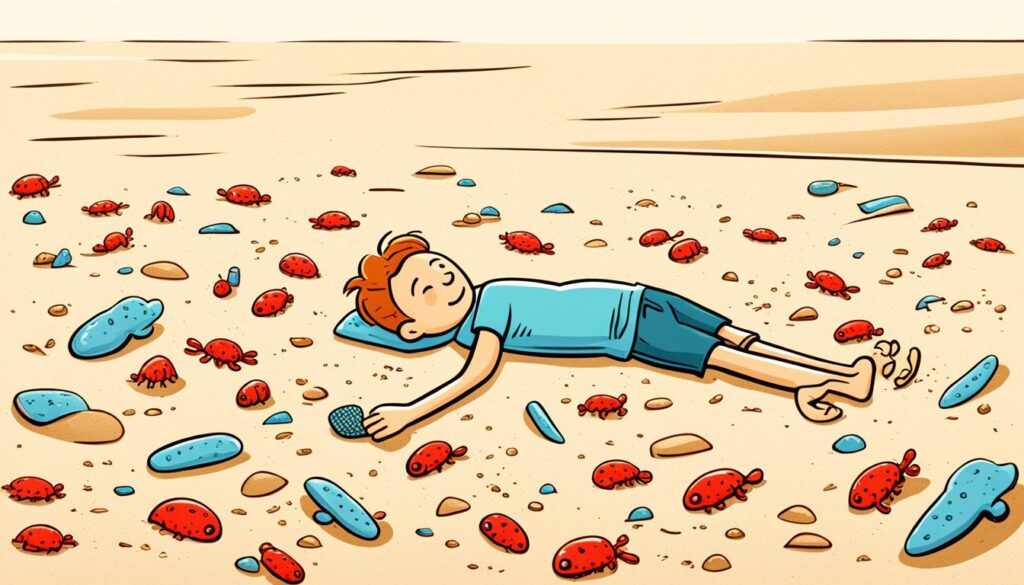
Understanding Sand Fleas versus Sandflies
“The bites and welts experienced at beaches and coastal areas are not caused by sand fleas but by biting fly insects known as sandflies.”
Sand fleas live in sandy places. Sandflies, which bite humans, are found in coastal areas. Their bites are itchy and uncomfortable.
Preventing Bites and Enjoying the Outdoors
To keep sandflies and other biting insects away, take these steps:
- Use insect repellents containing DEET or other recommended ingredients.
- Wear long-sleeved shirts, long pants, and closed-toe shoes.
- Avoid outdoor activities during peak sandfly activity times, such as dawn and dusk.
- Stay in well-screened areas or use a mosquito net while sleeping.
- Regularly check and maintain screens on windows and doors to prevent entry.
Following these tips can help you stay bite-free and enjoy the outdoors more.
| Common Misconception | Fact |
|---|---|
| Sand fleas are responsible for itchy bites at the beach. | Sand fleas do not bite humans or pets and are not the cause of beach bites. |
| Sand fleas are dangerous to humans. | Sand fleas do not pose any harm to humans and are harmless creatures. |
| Preventing sand flea bites requires specific measures. | No specific prevention measures are needed for sand flea bites as they do not bite humans. |
Sand Flea Bites and Sandfly Bites
Both sand flea bites and sandfly bites can cause small red bumps on your skin. Yet, it’s important to know sand flea bites are mostly harmless. They rarely cause severe allergic reactions.
Sand fleas are also called beach fleas. They usually feed on dead seaweed and plankton. Sometimes, female sand fleas bite humans to get blood for their eggs.
Sand flea bites don’t usually lead to severe allergic reactions. They might cause a bit of itching and discomfort. But these symptoms often go away in a few days. Using an anti-itch cream or taking antihistamines can help.
Sandfly bites, however, are more concerning. They can spread diseases. Sandflies, small insects in the Phlebotomus genus, carry parasites that cause leishmaniasis and sandfly fever.
Symptoms of Sandfly Bites:
- Redness and swelling at the bite site
- Intense itching and discomfort
- Formation of blisters or ulcers
- Fever and body aches (in case of disease transmission)
If bitten and you show symptoms, seeing a doctor is crucial. It helps rule out infections or diseases.
To tell sand flea bites apart from sandfly bites, look at the insect’s behavior, habitat, and symptoms. Knowing which insect bit you is key to treating and preventing further bites.
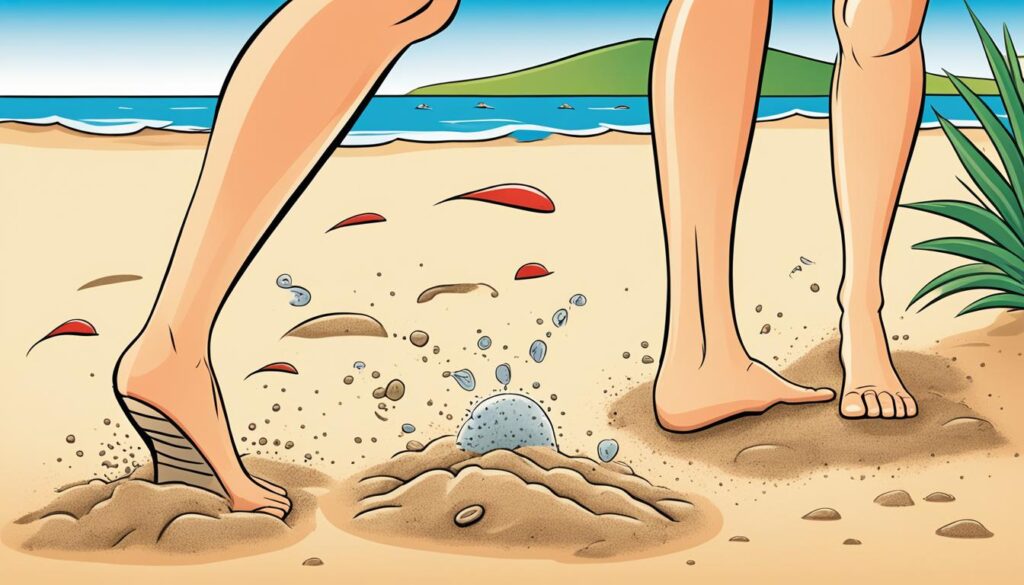
Understanding these differences is vital. It helps people avoid these bites and reduce their risks.
Treatment and Prevention of Sand Flea Bites
The best way to handle sand flea bites combines treatment and prevention. This part talks about how to treat and prevent these bites.
Treatment Options
If sand fleas bit you, it’s important to care for the bites right away. Here’s what you can do:
- Sterile Surgical Removal: If you see fleas on your skin, remove them with clean tools to avoid infection. Clean the area well after.
- Topical Medications: Use a cream with dimethicone to ease sand flea bite symptoms. Products for head lice often have this ingredient.
Always talk to a healthcare expert for advice on sand flea bites.
Prevention Tips
Avoiding sand flea bites is crucial. Follow these tips:
- Use Repellents: Spray on repellents that have DEET or coconut oil to keep sand fleas away. Reapply as the label suggests.
- Avoid Peak Activity Times: Sand fleas are most active at dawn and dusk. Stay off the beach at these times to avoid bites.
- Use Barriers: Place towels or sit in beach chairs to keep your skin off the sand and fleas away.
- Wear Shoes: Shoes provide extra protection against sand flea bites at the beach.
With these prevention tips, you can enjoy the beach with less worry about sand fleas.

| Treatment | Prevention |
|---|---|
| Sterile Surgical Removal | Use Repellents |
| Topical Medications | Avoid Peak Activity Times |
| Use Barriers | |
| Wear Shoes |
Being active in treatment and prevention lets you enjoy a beach time free from bug bites.
Sand Flea Habitat and Behavior
Sand fleas live in coastal areas, sandy beaches, and even deserts. They thrive in sandy environments, where they can find lots of sand and organic debris. They make their homes near the water where waves hit the shore.
These creatures need oxygenated water to stay alive. They use their gills to breathe under the sand. This lets them find food like seaweed and decaying plants that come ashore.
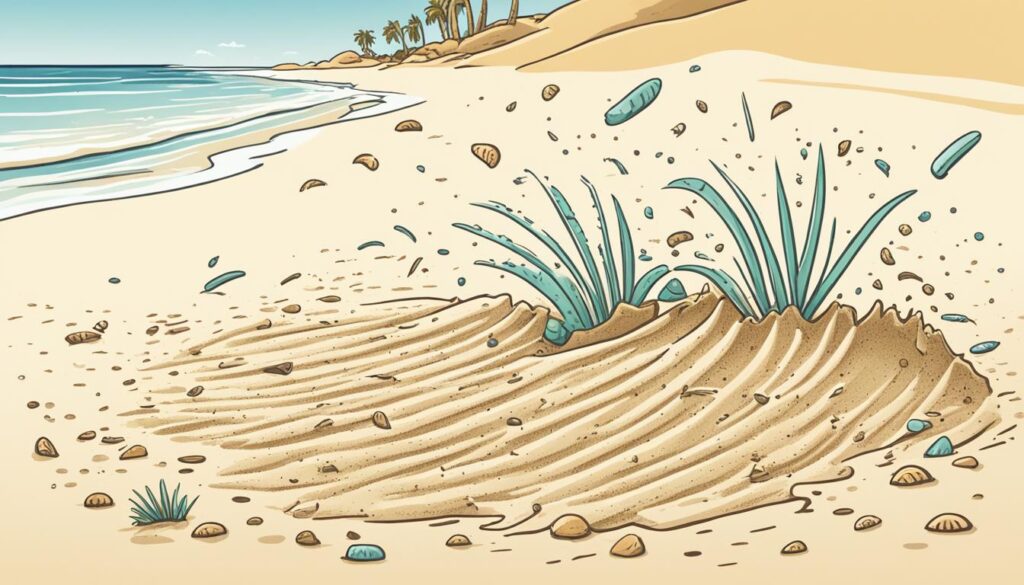
Sand fleas don’t have wings and aren’t true fleas. They hide in the sand most of the time, with just their antennae and eyes sticking out. They are busiest at dawn and dusk, when they leave their burrows to eat and find mates.
“The sandy environment provides sand fleas with the perfect conditions to burrow and create small colonies near the swash-zone.”
Sometimes, sand fleas might bite humans for blood. But this doesn’t happen often. Most of the time, their bites aren’t a big worry.
Coastal Areas and Sand Flea Behavior
Coastal areas are perfect for sand fleas because of all the sand and organic stuff there. The waves keep the sand moving, making it a great place for them to live.
Sand fleas are more active in these areas at certain times and conditions. They are around more in the warmer months. Knowing how they behave helps us avoid getting bitten.
| Characteristic | Description |
|---|---|
| Habitat | Coastal areas, sandy beaches, marshes, and deserts |
| Behavior | Primarily active at dawn and dusk, burrowed in sand during the rest of the day |
| Feeding | Prefer organic debris, occasionally bite humans for blood meals |
To avoid sand flea bites, beachgoers should know when and where they’re active. Stay out of sandy areas when they’re most active. Use bug spray and wear clothes that cover your skin.
The Difference Between Sand Fleas and Other Fleas
Sand fleas are not true fleas like the ones on cats and dogs. They are more like crustaceans, such as lobsters and crabs. Sand fleas live in sandy areas. Other fleas prefer living on pets and behave differently.
Cat fleas mostly live on cats but can be found on dogs too. Dog fleas prefer dogs but sometimes live on cats. These fleas have special ways to survive and thrive on their animal hosts.
Cat and dog fleas can bite humans and pets for blood. Their bites are itchy and can cause allergic reactions. They can carry diseases like Bartonellosis and Flea Allergy Dermatitis (FAD).
It’s important to know the difference between sand fleas and other fleas. Sand fleas are harmless and live in sand. Cat and dog fleas need blood to live and can be harmful.
Comparison Table: Sand Fleas vs. Cat and Dog Fleas
| Aspect | Sand Fleas | Cat Fleas | Dog Fleas |
|---|---|---|---|
| Habitat | Sandy areas, beaches, coastal marshes | Infests cats, occasional infestations on dogs | Infests dogs, occasional infestations on cats |
| Feeding Behavior | Primarily scavengers, feed on organic debris | Parasitic, feed on blood from cats, dogs, and other animals | Parasitic, feed on blood from dogs and occasionally cats |
| Biting Humans | Do not bite humans or pets | Can bite humans and cause irritation, itching, and allergic reactions | Can bite humans and cause irritation, itching, and allergic reactions |
| Diseases Carried | N/A | Bartonellosis, Flea Allergy Dermatitis (FAD), among others | Bartonellosis, Flea Allergy Dermatitis (FAD), among others |
By learning about these differences, people can better deal with flea issues. Knowing sand fleas are harmless eases worries. Yet, knowing about cat and dog fleas helps people protect their pets and themselves.
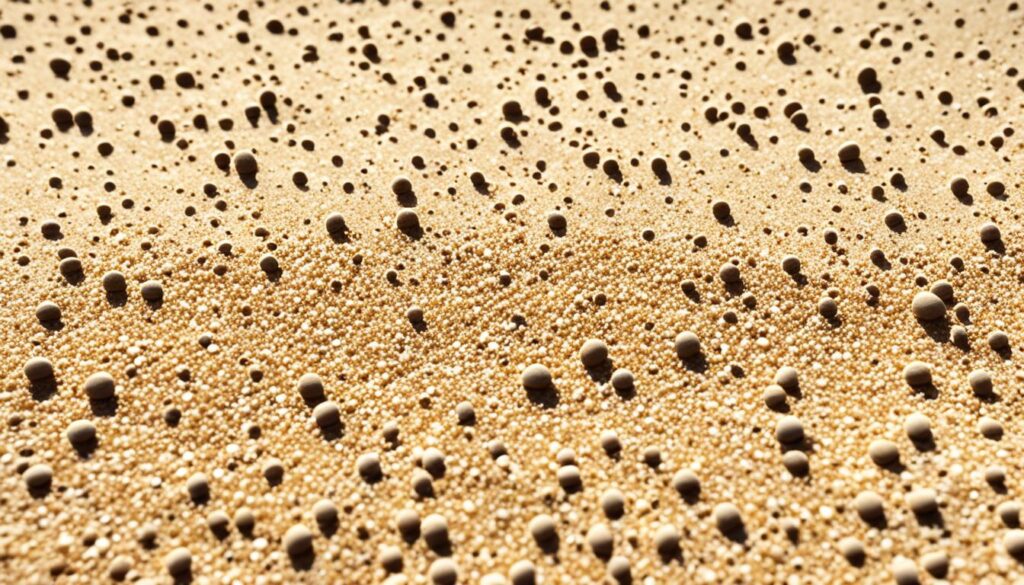
Precautions to Avoid Sand Flea Bites
Taking steps can keep you safe from sand flea bites at the beach.
- Avoid the beach during peak sand flea activity times.
- Use towels or beach chairs to put a barrier between you and the sand.
- Wear shoes to protect your feet and ankles from bites.
- Apply a DEET repellent to keep sand fleas away.
- Stay away from the beach right after it rains because sand fleas get more active then.
By doing these things, you can lower your chances of getting bitten by sand fleas. It makes for a better time at the beach.
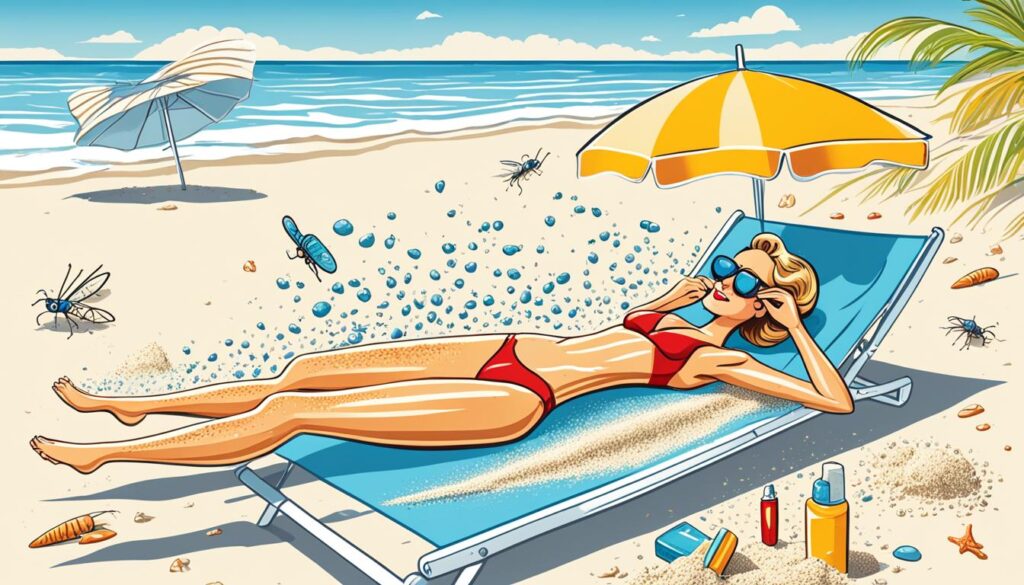
Conclusion
Sand fleas are harmless to humans and pets. Many think they bite, but that’s a mix-up with sandfly bites. If bitten, you need surgery and medicine to treat them.
To avoid bites, use repellents and be safe at the beach. Knowing sand fleas from other types helps. You can then prevent bites effectively.
Don’t worry about sand fleas when you go to the beach. With the right knowledge and care, you can have fun without the fear of bites. Stay informed, protect yourself, and enjoy the beach!

